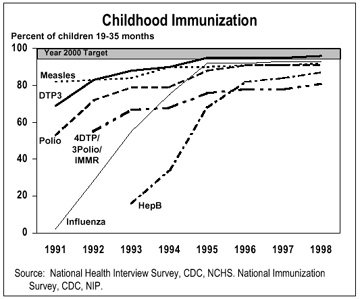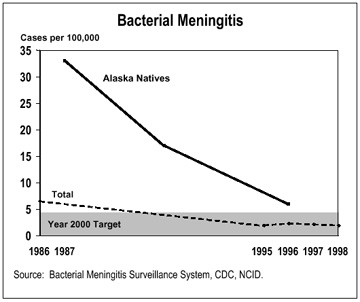

The Assistant Secretary for Health and Surgeon General chaired the third and final review of progress in achieving Healthy People 2000 objectives for Immunization and Infectious Diseases. The review was organized by the Centers for Disease Control and Prevention (CDC), the lead agency for this Healthy People 2000 priority area. The proceedings were broadcast by satellite to viewers at remote sites, who were able to submit questions by telephone and fax. A taped version of the live broadcast, as well as materials relating to the broadcast, as well as materials relating to the broadcast, may be viewed at www.cdc.gov/ncidod/healthypeople/. While data for the decade are not yet complete, of the 19 objectives in the priority area, two have met their targets and six are moving in the right direction. Six others show mixed progress, three have moved away from their targets, and two lack recent data. Discussion focused on the following objectives in priority area 20 of Healthy People 2000:
20.1 For the six vaccine-preventable diseases with a Healthy People 2000 target of zero cases, 1998 data show the following: one case of diphtheria among people aged <25 (no change from the 1988 baseline); nine cases of tetanus among people aged <25 years (an increase of three cases from the 1988 baseline); zero cases of polio caused by wild virus (no change from the 1988 baseline); 100 cases of measles (continuing a downward trend from the 1988 baseline of 3,396 cases); 364 cases of rubella (an increase from the 1988 baseline of 225 cases); and seven cases of congenital rubella syndrome (a slight increase from the 1988 baseline of six cases). The number of cases of measles, rubella and congenital rubella syndrome rose sharply in the early 1990s, but has since declined. The incidence of mumps decreased from 4,866 cases in 1988 to 666 cases in 1998, nearing the target of 500 cases. The incidence of pertussis reached 7,796 cases in 1996 and showed a general increase over the decade from 3,450 cases in 1988 to 7,405 cases in 1998, moving away from the target of 1,000 cases.
20.2 Tracked in 3-year moving averages, the rate of epidemic-related pneumonia and influenza deaths among people aged 65 and over fluctuated during the decade of the 1990s, reaching an average low of 15.7 cases per 100,000 in 1991-93 (target, 15.9 cases per 100,000). More recently, the 3-year average rate in 1994-96 was 17.3 cases per 100,000.
20.3 The estimated incidence of hepatitis A infection fluctuated in the 1990s ranging from 43.3 cases per 100,000 in 1989 to 27.2 cases per 100,000 in 1992. The overall rate decreased from 33.0 cases per 100,000 in 1987 to 25.8 in 1998, nearing the year 2000 target of 16.1 cases per 100,000. The rate of hepatitis A among Hispanics increased to 72.6 cases per 100,000 in 1997, before decreasing to 41.0 in 1998, nearing the target of 26.9. The rate among American Indians/Alaska Natives declined dramatically from 256.0 cases per 100,000 in 1992 to 30 per 100,000 in 1998, surpassing the target of 128.
The estimated incidence of hepatitis B decreased from 63.5 cases per 100,000 in 1987 to 22.5 cases per 100,000 in 1998 (target, 40). Targets set for special populations have also been achieved for all groups except heterosexually active people, men who have sex with men, and children of Asians/Pacific Islanders, although the estimated number of hepatitis B cases among the third group decreased from 10,817 cases in 1987 to 4,281 in 1998 (target, 1,500).
The overall estimated rate of hepatitis C declined from 18.3 cases per 100,000 in 1987 to 2.4 cases per 100,000 in 1997, surpassing the target of 13.7. Among Hispanics, the rate of hepatitis C declined from 17.2 cases per 100,000 in 1992 to 7.7 in 1996 (target, 13.7).
20.4 From 9.1 cases per 100,000 in 1988, the tuberculosis case rate in the U.S. rose to 10.5 in 1992, then decreased to 6.8 in 1998, well above the year 2000 target of 3.5. Among special populations, the rate also fluctuated during this period, although these populations continue to have higher rates than the entire U.S. population. In 1998, the rate for Asians/Pacific Islanders was 36.6 cases per 100,000 (target, 15.0); for Blacks, 17.8 (target, 10.0); for Hispanics, 13.6 (target, 5.0); and for American Indians/Alaska Natives, 12.6 (target, 5.0). The resurgence of tuberculosis from 1985 to 1992 was associated with the HIV epidemic, imported cases from immigrants from tuberculosis-endemic areas, and the occurrence of multi-drug resistant strains of the disease.
20.5 In 1999, preliminary data show that the surgical wound infection rate was 1.4 per 100 operations for low-risk patients (compared with 1.1 in 1986-90 and the year 2000 target of 1.0); 2.3 for medium-low-risk patients (3.2 in 1986-90, with the target of 2.9); 3.9 for medium-high-risk patients (6.3 in 1986-90, with the target of 5.7); and 5.7 for high-risk patients (14.4 in 1986-90, with the target of 13.0). Thus, only the target for low-risk patients appears not to have been met.
20.7 The rate of infection with bacterial meningitis decreased from 6.5 cases per 100,000 in 1986 to 1.9 in 1998, well below the year 2000 target of 4.7. Among Alaska Natives, a group particularly at risk, the infection rate fell from 33 cases per 100,000 in 1987 to 6.0 in 1996, also below its target of 8 cases per 100,000. (See chart following.)
20.11 In 1998, vaccination coverage at a national level among children aged 19-35 months was 96% with diphtheria-tetanus-pertussis or DTP (three or more doses); 91% with poliovirus vaccine; 92% with measles-mumps-rubella (MMR); 93% with Haemophilus influenzae type b or Hib (three or more doses); 87% with hepatitis B (three or more doses); and 81% with the combined series 4DTP/ 3polio/1MMR. (See chart.) However, not all geographic areas and population subgroups achieved the year 2000 target of 90% for each vaccine type.
In 1997, the rate of pneumococcal vaccination among non-institutionalized people aged 65 years and older was 43%, 22% for Blacks, and 23% for Hispanics. The comparable baseline levels in 1989 were 15%, 6% and 11%, respectively. The year 2000 target is 60%. The influenza vaccination coverage rate for non-institutionalized people aged 65 years and older was 63% in 1997 ( 33% in 1989), exceeding the target of 60%. However, the rate for Blacks in that age group in 1997 was only 45% (20% in 1989), and for Hispanics, 53% (28% in 1989).
20.18 The proportion of infected people who had completed preventive
therapy for tuberculosis changed little over the decade; it was 66.3% in 1987 and 62.2% in 1997.
The year 2000 target is 85%.



Progress Review Page | Healthy People 2000 Home Page | ODPHP | NHIC